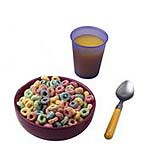
MONDAY, Nov. 25, 2013 (HealthDay News) — Having youngsters use smaller bowls may be one way to help reduce childhood obesity, a new study suggests.
In their first experiment, researchers gave 8- or 16-ounce bowls to 69 preschoolers. Adults then served the children cereal and milk in increments until the children said they’d had enough. Children with the larger bowls asked for 87 percent more cereal and milk.
How much kids weighed or whether they were boys or girls did not affect how much food they requested.
A second experiment included 18 elementary school students who were given smaller or larger bowls. Secret scales were embedded within the tables to weigh each child’s serving and to determine how much the children ate. Those with larger bowls asked for 69 percent more cereal and milk, and ate 52 percent more than those with smaller bowls.
“Bigger bowls cause kids to request nearly twice as much food, leading to increased intake as well as higher food waste,” study author Brian Ven Ittersum, a professor of behavioral economics at Cornell University, said in a university news release.
“Based on these findings, using smaller dishware for children may be a simple solution for caregivers who are concerned about their kids’ caloric intake,” he said.
The study was published online Nov. 18 in the Journal of Pediatrics.
More information
The U.S. Office of Disease Prevention and Health Promotion explains how to keep children at a healthy weight.
Copyright © 2025 HealthDay. All rights reserved.

